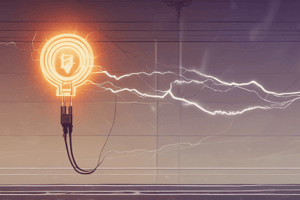Podcast
Questions and Answers
What does Ohm’s law state about the relationship between voltage, current, and resistance?
What does Ohm’s law state about the relationship between voltage, current, and resistance?
- Resistance increases as voltage decreases.
- Voltage is inversely proportional to current.
- Current remains constant regardless of voltage changes.
- Current is directly proportional to the potential difference, given constant temperature. (correct)
If a circuit has a voltage of 15 V and a resistance of 3 Ω, what is the current flowing through the circuit?
If a circuit has a voltage of 15 V and a resistance of 3 Ω, what is the current flowing through the circuit?
- 45 A
- 5 A (correct)
- 0.2 A
- 3 A
Which of the following correctly rearranges Ohm's law to solve for resistance?
Which of the following correctly rearranges Ohm's law to solve for resistance?
- R = I/V
- R = I + V
- R = V/I (correct)
- R = V × I
In a circuit, if the current is 2 A and the voltage is 12 V, what is the resistance?
In a circuit, if the current is 2 A and the voltage is 12 V, what is the resistance?
Which component in a simple electric circuit is used to measure current?
Which component in a simple electric circuit is used to measure current?
What is the current (I) when the voltage (V) is 110 V and the resistance (R) is 550 Ω?
What is the current (I) when the voltage (V) is 110 V and the resistance (R) is 550 Ω?
How much resistance (R) is present if the voltage (V) is 230 V and the current (I) is 1.2 A?
How much resistance (R) is present if the voltage (V) is 230 V and the current (I) is 1.2 A?
What will be the voltage (V) in a circuit with a current (I) of 0.5 A and a resistance (R) of 100 Ω?
What will be the voltage (V) in a circuit with a current (I) of 0.5 A and a resistance (R) of 100 Ω?
If the current (I) is 0.0024 A in a circuit with a voltage (V) of 24 V, what is the resistance (R)?
If the current (I) is 0.0024 A in a circuit with a voltage (V) of 24 V, what is the resistance (R)?
How would you express 0.001 A in microamperes?
How would you express 0.001 A in microamperes?
What is the consequence of increasing the voltage in a circuit with a constant resistance according to Ohm’s law?
What is the consequence of increasing the voltage in a circuit with a constant resistance according to Ohm’s law?
If you double the resistance in a circuit with a constant voltage, how will the current be affected?
If you double the resistance in a circuit with a constant voltage, how will the current be affected?
When using a voltmeter in a circuit, what is it primarily measuring?
When using a voltmeter in a circuit, what is it primarily measuring?
Calculate the current (I) when the voltage (V) is 230 V and resistance (R) is 500 Ω.
Calculate the current (I) when the voltage (V) is 230 V and resistance (R) is 500 Ω.
What is the resistance (R) when the voltage (V) is 110 V and the current (I) is 0.2 A?
What is the resistance (R) when the voltage (V) is 110 V and the current (I) is 0.2 A?
Determine the voltage (V) if the current (I) is 0.0024 A and resistance (R) is 10 kΩ.
Determine the voltage (V) if the current (I) is 0.0024 A and resistance (R) is 10 kΩ.
What is the current (I) when the voltage (V) is 50 V and resistance (R) is 100 Ω?
What is the current (I) when the voltage (V) is 50 V and resistance (R) is 100 Ω?
What is the current (I) if the voltage (V) is 24 V and the resistance (R) is expressed as 10 kΩ?
What is the current (I) if the voltage (V) is 24 V and the resistance (R) is expressed as 10 kΩ?
Flashcards are hidden until you start studying
Study Notes
Ohm's Law
- Ohm's law defines the relationship between voltage (V), current (I), and resistance (R) in electrical circuits with the formula: V = I × R.
- The law illustrates that current is directly proportional to voltage when resistance is constant, applicable at a constant temperature.
- Units of measurement:
- Voltage (V) is measured in volts.
- Current (I) is measured in amperes (A).
- Resistance (R) is measured in ohms (Ω).
Georg Simon Ohm
- Georg Simon Ohm discovered the law governing the interaction between voltage, current, and resistance.
- The discovery is fundamental for understanding electrical circuits and is widely used in electrical engineering.
Practical Applications
- Ohm's law is commonly applied to determine unknown values in electric circuits:
- To find voltage (V), rearrange to V = I × R.
- To find current (I), use I = V / R.
- To find resistance (R), use R = V / I.
Worked Examples
- Example calculation for voltage:
- If I = 0.5 A and R = 20 Ω, then V = 0.5 A × 20 Ω = 10 V.
- Example calculation for current:
- For a load of 500 Ω with a supply of 230 V, the current is I = 230 V / 500 Ω = 0.46 A.
Practice Questions
- Formula rearrangements can help solve for V, I, or R:
- Given I = 0.5 A and R = 100 Ω, V = 0.5 A × 100 Ω = 50 V.
- For V = 110 V and R = 550 Ω, calculate I: I = 110 V / 550 Ω = 0.2 A.
- For V = 230 V and I = 1.2 A, calculate R: R = 230 V / 1.2 A = 191.67 Ω.
- If V = 24 V and R = 10 kΩ, then I = 24 V / 10,000 Ω = 0.0024 A.
Units and Conversions
- Common prefixes:
- M (mega) = 1,000,000
- k (kilo) = 1,000
- m (micro) = 0.000001
- Important conversions:
- 1 kΩ = 1,000 Ω; 10 kΩ = 10,000 Ω;
- 1 MΩ = 1,000,000 Ω.
Experimentation
- Connecting components in electric circuits, such as voltmeters, ammeters, loads, and power supplies, can verify Ohm's law through practical demonstrations.
Ohm's Law
- Ohm's law defines the relationship between voltage (V), current (I), and resistance (R) in electrical circuits with the formula: V = I × R.
- The law illustrates that current is directly proportional to voltage when resistance is constant, applicable at a constant temperature.
- Units of measurement:
- Voltage (V) is measured in volts.
- Current (I) is measured in amperes (A).
- Resistance (R) is measured in ohms (Ω).
Georg Simon Ohm
- Georg Simon Ohm discovered the law governing the interaction between voltage, current, and resistance.
- The discovery is fundamental for understanding electrical circuits and is widely used in electrical engineering.
Practical Applications
- Ohm's law is commonly applied to determine unknown values in electric circuits:
- To find voltage (V), rearrange to V = I × R.
- To find current (I), use I = V / R.
- To find resistance (R), use R = V / I.
Worked Examples
- Example calculation for voltage:
- If I = 0.5 A and R = 20 Ω, then V = 0.5 A × 20 Ω = 10 V.
- Example calculation for current:
- For a load of 500 Ω with a supply of 230 V, the current is I = 230 V / 500 Ω = 0.46 A.
Practice Questions
- Formula rearrangements can help solve for V, I, or R:
- Given I = 0.5 A and R = 100 Ω, V = 0.5 A × 100 Ω = 50 V.
- For V = 110 V and R = 550 Ω, calculate I: I = 110 V / 550 Ω = 0.2 A.
- For V = 230 V and I = 1.2 A, calculate R: R = 230 V / 1.2 A = 191.67 Ω.
- If V = 24 V and R = 10 kΩ, then I = 24 V / 10,000 Ω = 0.0024 A.
Units and Conversions
- Common prefixes:
- M (mega) = 1,000,000
- k (kilo) = 1,000
- m (micro) = 0.000001
- Important conversions:
- 1 kΩ = 1,000 Ω; 10 kΩ = 10,000 Ω;
- 1 MΩ = 1,000,000 Ω.
Experimentation
- Connecting components in electric circuits, such as voltmeters, ammeters, loads, and power supplies, can verify Ohm's law through practical demonstrations.
Studying That Suits You
Use AI to generate personalized quizzes and flashcards to suit your learning preferences.




